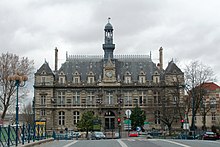Pantin
Pantin is located on the edge of the city of Paris and is mainly formed by a plain crossed by national roadway 2 and 3, the Paris–Strasbourg railway line and the canal de l'Ourcq.
Pantin borders the Paris Boulevard Périphérique, an inner ring road, and is traversed by national routes N2 and N3, as well as the Paris-Strasbourg railway line and the Ourcq canal.
[9][10] The main quarters or neighborhoods of the commune are: Jacqueline Osty, winner of the Grand Prix de l'urbanisme in 2020, designed the 3.5 hectares (8.6 acres) of public spaces on the port site.
She has forged a common base, preserving a continuous, mineral spirit, evocative of the port area's past, with a light use of vegetation in the form of long, straight grassed lines and green lounges between the housing developments.
[11] The name Pantin was recorded for the first time in 1067 as Pentini, perhaps from the Roman patronym Pentinus, a variant of Pantaenus or Repentinus, but this etymology is not certain.
The construction of a science park along the Bassin de la Villette on the former site of city abattoirs has improved pedestrian access to Paris, as well as encouraging urban regeneration in Pantin itself.
A key policy discussed since the 2008 mayoral election has been the possibility of integrating the ten banlieue towns of Bagnolet, Les Lilas, Le Pré-Saint-Gervais, Romainville, Pantin, Noisy-le-Sec, Montreuil, Bobigny, Bondy and Rosny-sous-Bois into an "intercommune" of around 440,000 people.
3,000 employees of BNP Paribas Securities Services were installed in the historic building Grands Moulins de Pantin at the end of October 2009.
Outside the hours of normal public transport the town is served by the N13 and N142 Noctilien night bus services with stops outside the Centre de la Danse, the Mairie and Rue Delizy.



